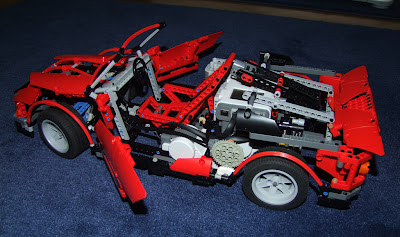Being fascinated by supercars both in the Technic sphere and in the real world, it was about time I started building another one. Unfortunately, the fascination itself is by no means sufficient to build a good Technic supercar, as is easily demonstrated by this terrible failure - probably the worst MOC I've done for quite some time. Despite it being awful, I've at least decided to document it here as it may help other builders to avoid all classic sevety-six mistakes I've done designing it.
It's powered by NXT electrics: one motor provides the drive to the rear wheels, other handles the steering, and the third flicks a PF switch to turn on the lights, to avoid requiring more than one remote control. It also has full independent suspension based on the parts from the 8070 Supercar, which works nicely. The doors are openable manually, and the steering wheel works as well.
 So, you can already notice how scarce it is with functionality: good builders can easily cram infinitely more stuff into a car of this size (69x29 studs footprint). It is a consequence of my anomalous obsession with as strong and ideally weight-distributed chassis as possible, leaving very little possibility to change the components layout later. In other words, I've done a mistake by treating a chassis as a local problem, which it certainly isn't in a supercar that has to use every cubic centimeter of space wisely and well-coordinated with other components. Of course, the chassis thus limited the scope of possibilities regarding the bodywork. That's why there are large pointless empty areas within the bodywork (especially right behind the nose and under the rear wing). The chassis could have been reworked, but I've decided rather to keep it and keep the intelligent approach for the next car.
So, you can already notice how scarce it is with functionality: good builders can easily cram infinitely more stuff into a car of this size (69x29 studs footprint). It is a consequence of my anomalous obsession with as strong and ideally weight-distributed chassis as possible, leaving very little possibility to change the components layout later. In other words, I've done a mistake by treating a chassis as a local problem, which it certainly isn't in a supercar that has to use every cubic centimeter of space wisely and well-coordinated with other components. Of course, the chassis thus limited the scope of possibilities regarding the bodywork. That's why there are large pointless empty areas within the bodywork (especially right behind the nose and under the rear wing). The chassis could have been reworked, but I've decided rather to keep it and keep the intelligent approach for the next car.I'm not satisfied with the looks either. While the rear could be acceptable, the engine cover is rudimentary, the doors are too small and long, the windshield and the seat are out of proportion, and the whole nose of the car is a bit too small (looks like an old VW Beetle somewhat), and ugly. Again, I have not had a sufficiently clear vision of what should the car look like when finished, and it shows.
But other than that, this is just an oversized, ugly, fragile and slow wheelie bin with functionalities on a level of a 8090 set car. But it prooves the point which, ironically, I've already written in the Technic building tips and have now violated: for a tight and difficult machine such as a supercar, you really need a clear vision of what exactly are you going to build, before you even pick the first brick up.
 I sincerely hope the next one will be better, to appease the Gods of Lego, though I may need to rehabilitate on Classic Space for a while.
I sincerely hope the next one will be better, to appease the Gods of Lego, though I may need to rehabilitate on Classic Space for a while.



